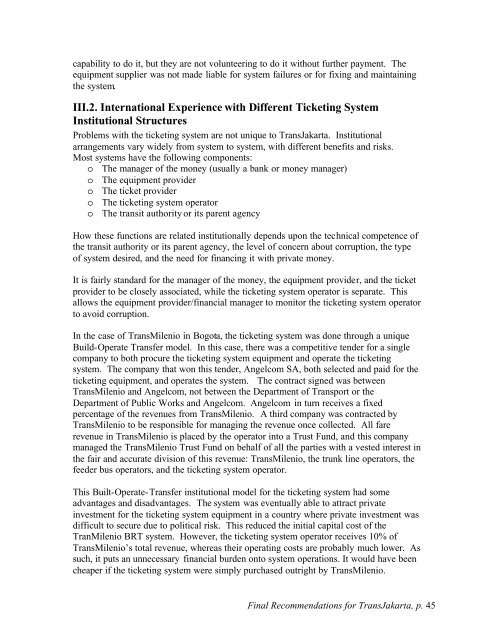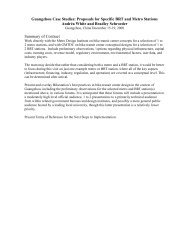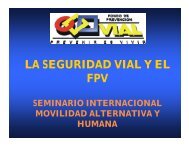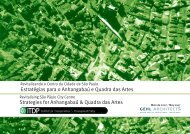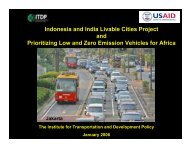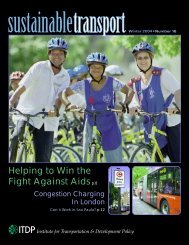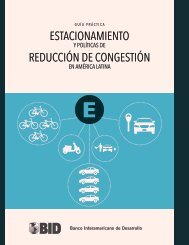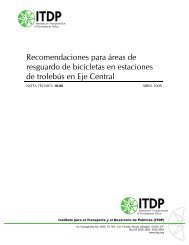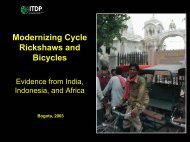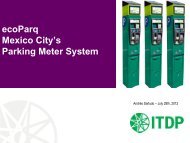Making TransJakarta a World Class BRT System - ITDP | Institute for ...
Making TransJakarta a World Class BRT System - ITDP | Institute for ...
Making TransJakarta a World Class BRT System - ITDP | Institute for ...
Create successful ePaper yourself
Turn your PDF publications into a flip-book with our unique Google optimized e-Paper software.
capability to do it, but they are not volunteering to do it without further payment. The<br />
equipment supplier was not made liable <strong>for</strong> system failures or <strong>for</strong> fixing and maintaining<br />
the system.<br />
III.2. International Experience with Different Ticketing <strong>System</strong><br />
Institutional Structures<br />
Problems with the ticketing system are not unique to <strong>TransJakarta</strong>. Institutional<br />
arrangements vary widely from system to system, with different benefits and risks.<br />
Most systems have the following components:<br />
o The manager of the money (usually a bank or money manager)<br />
o The equipment provider<br />
o The ticket provider<br />
o The ticketing system operator<br />
o The transit authority or its parent agency<br />
How these functions are related institutionally depends upon the technical competence of<br />
the transit authority or its parent agency, the level of concern about corruption, the type<br />
of system desired, and the need <strong>for</strong> financing it with private money.<br />
It is fairly standard <strong>for</strong> the manager of the money, the equipment provider, and the ticket<br />
provider to be closely associated, while the ticketing system operator is separate. This<br />
allows the equipment provider/financial manager to monitor the ticketing system operator<br />
to avoid corruption.<br />
In the case of TransMilenio in Bogota, the ticketing system was done through a unique<br />
Build-Operate Transfer model. In this case, there was a competitive tender <strong>for</strong> a single<br />
company to both procure the ticketing system equipment and operate the ticketing<br />
system. The company that won this tender, Angelcom SA, both selected and paid <strong>for</strong> the<br />
ticketing equipment, and operates the system. The contract signed was between<br />
TransMilenio and Angelcom, not between the Department of Transport or the<br />
Department of Public Works and Angelcom. Angelcom in turn receives a fixed<br />
percentage of the revenues from TransMilenio. A third company was contracted by<br />
TransMilenio to be responsible <strong>for</strong> managing the revenue once collected. All fare<br />
revenue in TransMilenio is placed by the operator into a Trust Fund, and this company<br />
managed the TransMilenio Trust Fund on behalf of all the parties with a vested interest in<br />
the fair and accurate division of this revenue: TransMilenio, the trunk line operators, the<br />
feeder bus operators, and the ticketing system operator.<br />
This Built-Operate-Transfer institutional model <strong>for</strong> the ticketing system had some<br />
advantages and disadvantages. The system was eventually able to attract private<br />
investment <strong>for</strong> the ticketing system equipment in a country where private investment was<br />
difficult to secure due to political risk. This reduced the initial capital cost of the<br />
TranMilenio <strong>BRT</strong> system. However, the ticketing system operator receives 10% of<br />
TransMilenio’s total revenue, whereas their operating costs are probably much lower. As<br />
such, it puts an unnecessary financial burden onto system operations. It would have been<br />
cheaper if the ticketing system were simply purchased outright by TransMilenio.<br />
Final Recommendations <strong>for</strong> <strong>TransJakarta</strong>, p. 45


